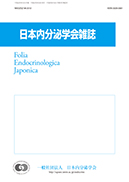All issues

Volume 67 (1991)
- Issue 12 Pages 1295-
- Issue 11 Pages 1231-
- Issue 10 Pages 1147-
- Issue 9 Pages 14-
- Issue 8 Pages 811-
- Issue 7 Pages 755-
- Issue 6 Pages 655-
- Issue 5 Pages 587-
- Issue 4 Pages 19-
- Issue 3 Pages 175-
- Issue 2 Pages 57-
- Issue 1 Pages 1-
- Issue Supplement-3 Pa・・・
- Issue Supplement-2 Pa・・・
- Issue Supplement-1 Pa・・・
Predecessor
Volume 26, Issue 3-4
Displaying 1-2 of 2 articles from this issue
- |<
- <
- 1
- >
- >|
-
Masuichi TAKINO1950 Volume 26 Issue 3-4 Pages 25-41
Published: 1950
Released on J-STAGE: September 24, 2012
JOURNAL FREE ACCESSDownload PDF (2130K) -
Especially on the Relation Between the Pineal Gland and the Thyroid or Parathyroid Glands, Indicated by the Abnormal Salt-feverKOTA NAKAI1950 Volume 26 Issue 3-4 Pages 42-66_1
Published: July 20, 1950
Released on J-STAGE: September 24, 2012
JOURNAL FREE ACCESSDr. K. Ito has formerly found abnormal salt-fever as a part of the deficiency syndromes following pinealectomy, but the pathogenes is not yet clear.
Prof. Y. Tokumitsu has emphasized from many experiments that the deficiency states of the endocrine organs are not merely negative phenomena resulting from lack of these hormones, but positive phenomena caused by the change of function of another endocrine organ.
I have studied the pathogenesis of the deficiency syndrome following pinealectomy by indicating the salt-fever of rabbits. The results are as follows:
1) The pinealectomized rabbit shows easily the NaCl-fever, for it is caused not only by negative phenomena resulting from lack of pineal hormone, but also by an active substance which appears in the blood of the animal and raises the abnormal NaCl fever. This substance is a product of the aberrated thyroid gland resulting from the disappearance of pineal hormone.
2) The pinealectomized rabbit becomes sensitive to the Cacl2 fever. Also this phenomenon is caused by the active substance in its blood which is produced by the secondary aberration of parathyroid function.
3) The above abnormal salt-fever after pinealectomy is not closely associated with spleen, thymus, genital gland, adrenal gland or pituitary gland function, but the above mentioned aberration of function of thyroid and parathyroid glands after pinealectomy returns to the normal state following removal of pituitary gland.View full abstractDownload PDF (4754K)
- |<
- <
- 1
- >
- >|